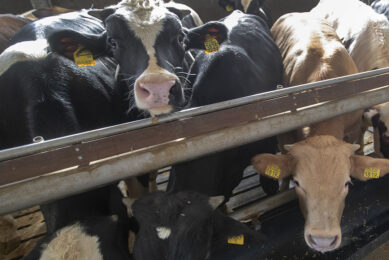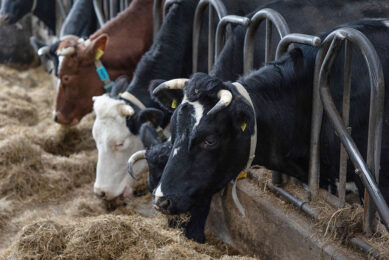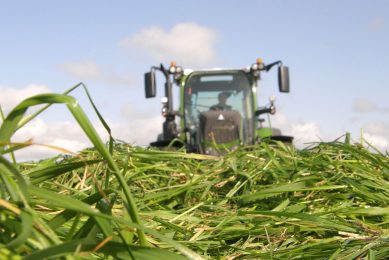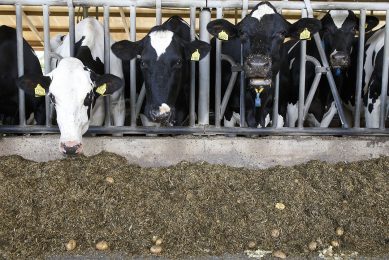German feedmiller successful in mechanically making bypass protein
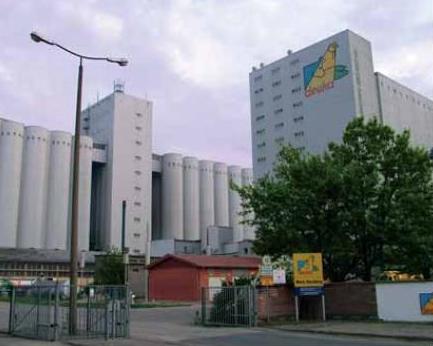
Dairy farmers do not want the protein in their cow’s feed to be digested by the microbes in the rumen. This means the protein has to be protected so it can bypass the stomachs and can be absorbed in the intestines. German feedmiller Deuka has experimented for a decade now with protecting protein with a high-temperature short-time extrusion system and gained successful results.
| The Deuka plant in Herzberg in the east of Germany staged a mini symposium on dairy nutrition. |
On the occasion of ten years of experience with HTST technology (named opticon) that started at Deuka feed milling, which is now part of Deutsche Tiernahrung Cremer (DTC) a mini seminar was organised at their feed plant in Herzberg, in the east of Germany. The focus was on dairy nutrition and management and of course the successful opticon technology, which is a patented system of DTC.
Dairy cattle management is going through a historic phase of radical change regarding yield and performance. Milk yields have improved on many farms and rise steadily putting high demands on the management and require detailed structuring of total feed rations. The quality of the basic diet, optimising of the dry matter intake, and consideration of the most recent findings on carbohydrate and protein metabolism are particularly important here. In recent years research has paid special attention to protein supplies for high-yielding cows.
“The most important source of protein – even at peak lactation – is and remains microbial protein. Optimal fermentation in the rumen means a corresponding strong microbial population,” said Dr Heinrich Kleine Klausing, chief nutritionist at DTC. At the seminar he explained that the highly digestible protein mass with an amino acid pattern that is almost optimal for the cow is conveyed towards the rennet or fourth stomach and small intestine via the constant flow of rumen fluid and feed particles with adherent rumen microbes. The higher the energy supply of the cow via the feed the more rumen-available nitrogen (urea, degradable protein) can be used successfully by the rumen microbes. “Therefore the energy supply is very important for a balanced supply with usable protein in the small intestine,” he said.
Protein deficiency
According to Kleine Klausing microbial protein covers the cow’s needs up to a daily milk production of 10-15 kg. With increasing daily milk production as well as in situations of limited energy supply (mainly at the beginning of the lactation) rumen-protected feed protein becomes important. With insufficient feed intake the lack of energy supply is balanced by the cow using her body fat reserves. But this energy cannot be used by the rumen microbes and less microbial protein is produced. If in this situation too much rumen-degradable protein and less energy for microbes becomes available, surplus ammonia develops in the rumen. This is absorbed and must be separated as urea under load of the liver and pressure on the health of the cow. “Fertility problems are often already programmed in this lack of harmony in the nutrient supplies for dairy cows,” he said.
The start of lactation for high yielding cows is another critical moment in feed supply. Many of these cows go through a negative energy balance for several weeks and the energy output with the milk is well above the energy intake with the feed. These cows mobilise their body reserves to balance the deficit and do this very efficiently since 1 kg of body fat supplies energy for 6-7 kg of milk. However, the protein supply does not keep pace and declines often below 3%. A lack of usable raw protein in the small intestine means for the cow at the same time an additional shortage of energy and a weakened immune system.
Bypass protein
| An expander or extruder is modified to DTC’s own standards, patented into the opticon process, to produce the bypass protein. |
The logical conclusion to be drawn from the above circumstances is that more protein should be allowed to ‘flow’ through the rumen directly into the small intestine. This UDP-share (share of Undegraded Dietary Protein in the rumen in relation to total protein) varies substantially in today’s available raw materials. For optimal performance the UDP-share should at least be 35% of overall protein in the total ration. Even optimal rations only reach a UDP content of 25%. Soybean meal to supplement the protein shortage is now considered to have a UDP component of only 30% – just as much as rapeseed meal. To be able to achieve the 35% threshold the protein in the feed needs to be ‘protected’ for degradation by the rumen microbes. This can be done
| In ten years time many products have been developed with the opticon process, not only for ruminants, but also for pigs and poultry. |
chemically by treating with formaldehyde or xylose, or physically by extrusion, which causes a structural change in the protein. The mechanical process is very energy demanding and the
products need to be dried after treatment.DTC has in recent years looked intensively into new technologies for refining single and compound feeds by natural means and, if possible, without using additives. The result is the patented opticon technology, which is a HTST – high-temperature/short-time – extrusion process. With this technology deukalac UDP 39, the rumen protected protein feed for high-yielding cows is made. DTC now has ten years of experience with this technology. What started with one extruder has evolved in ten years time to the installation of nine opticon extruders and franchising of the technology to foreign countries.
Avoiding Maillard reaction
| Deukalac UDP 39 is an extruded mix of high protein soybean meal and 00-rapeseed meal with an appealing taste for cows. |
The opticon technology is characterised by the specific configuration of the screw in the extruder and the appropriate process parameters (temperature, moisture content, pressure, shear forces, dwelling time, energy dissipation, expansion and product structure). These parameters form the crucial basis for the uniqueness and high degree of improvement achieved in deukalac UDP 39. Also the bypass protein displays unchanged high protein digestibility of high biological value as tested in young growing monogastrics. The background here is the large scale avoidance of Maillard reactions (irreversible bondings between lysine and reducing sugars) in the product which are encountered in conventional extrusion technologies and particularly in processes using free sugars.Compared to other extrusion technologies for producing animal feed a distinctly lower energy input is used to achieve a certain substance conversion. Excessive moisture is extracted in the flash phase, which makes extra drying of treated products redundant. This also contributes to lower operational costs compared to full extrusion.
Soybean – rapeseed mix
| Heinrich Kleine Klausing was at the cradle of the opticon development. |
The final bypass protein product consists of 50% HP soybean meal and 50% 00-rapeseed meal. These are ground and mixed in the usual way and then treated in the opticon production plant. The content of rumen-stable protein (the UDP share) for supply covering the needs of high-yielding cows is increased to 60% (basic passage rate 8%/hr from the rumen). The content of sulphurous amino acids in the product is secured via the share of rapeseed meal. “We’ve looked at the lysine/methionine ratio in the cow’s milk, which is 1:0.26. Soybean and rapeseed supplement each other in their amino acid pattern to give a desired lysine/methionine ratio. With UDP 39 the ratio is 1:0.28 and thus very close to the ratio in the milk,” Kleine Klausing explains.The treatment of the soy/rape mix creates a unique crumbly structure and also gives the product a pleasant, baking like odour and taste, which improves intake by dairy cows. It is used readily on the farm for upgrading the basic ration as a protein supplement in mixed rations and total mixed rations, and as an additional protein supply for high-yielding cows in the top dressing. In feed plants UDP 39 is used in special compound feed varieties for high-yielding cows.
Data verification
When looking closely at process technologies to protect proteins against degradation in the rumen, and the resulting UDP content in the treated products it is interesting to know how forecasted data can be verified. Until the end of the 90’s the UDP content in a product could only be estimated via expensive experiments with rumen fistulated cows. But at the Christian Albrecht University in Kiel, Germany an in-vitro method was developed which was validated with results from the fistulated cow trials. The result is a process for estimating crude protein degradation in the rumen and hence the UDP share in the overall protein of a feed with the aid of chemical fractioning of the feed protein following the Cornell CNCPS-system. This process is relatively quick and can be carried out at reasonable expense. The data are stated as a function of a ruminal passage rate of 2.5% or 8%/hr.
This method was first used during the development of the opticon process technology to assess the degree of substance change achieved and hence UDP content in the single feed treated. The deukalac UDP 39 mix was repeatedly examined during development and within the framework of quality assurance to assess the UDP content achieved using this method too. The data show clearly that deukalac UDP 39 has a mean UDP 5 value of over 50% and a mean UDP 8 value of more than 60% for all samples examined. In the calculation of rations for high-performing dairy cows with the bypass protein, a UDP share in total protein of 60% is taken on the basis of this result.
Possible damage to the protein and possible resulting reduced digestibility and consequent deterioration of the biological value is shown most clearly in young growing monogastric animals. Data on the assessment of small intestine digestibility of the treated protein can only be obtained from in vivo investigations in which young growing rats are used. The tests with rats were carried out to study the protein quality of the treated products, on the one hand because this methodology has been standardised and verified for decades. On the other hand it was important for a critical assessment of the protein quality, especially in treated products, that in the rat as a monogastric animal the protein that is demonstrably protected to a certain percentage in the time unit prior to degradation is not subject to the influence of rumen microbes prior to digestion via the body’s own enzymes. The criterion ‘biological value’ permits a comparative relative classification of different feed proteins to each other.
Results in practice
A statistical analysis of results from 38 scientific studies with 206 experimental groups showed that 1% increase of the portion of UDP in the dry matter of the rations entailed an increase of milk
production of 1.85 kg. UDP already plays an important role in first-lactating cows before calving. An increase of the content of crude protein in the ration from 12.7% (30% UDP portion) to 14.7% (30% UDP portion) by feeding of bypass protein in the last three weeks before calving led to an increase of milk production by 3.1 kg in the first 120 days of lactation.Table 1shows the results from a scientific trial on the farm of Lycee La Touche in Brittanny, France, where 30 dairy cows split in a control and trial group were used in a UDP trial. “With replacement of 1 kg of soybean meal/rapeseed meal by 1 kg deukalac UDP 39 the cows in the trial group received 58g more by-pass protein per cow and day and that leads to an significant increase in daily milk yield of 1 kg,” Kleine Klausing said. “Interesting to see is the decrease in number of cells in the milk. This is a sign for better metabolism and with that for a better health of the cows. This was reported several times in practice as well.”
The data show that the use of deukalac UDP 39 under standard practice conditions leads to an increase in the milk production from 200 to 1,000 kg per year (Table 2).
Treated lupines
Since soybeans need to be imported and cannot be used for organic farms due to GMO-issues DTC tried lupines as a replacement, creating lupicon R, where the soybean fraction in the mix was replaced by lupines. With the opticon treatment this mix has a 55% UDP (at 8%/hr passage rate) and 31% raw protein. The technical HTST extrusion process indeed transforms the lupine protein to bypass protein. The process also reduces the antinutritional factors in lupins and also in rape seed. Compared to a soy/rape mix lupicon fed dairy cows showed the same milking performance. Introduction of lupicon on a large scale is difficult since the area planted is limited and GMO-free needs to be guaranteed.




